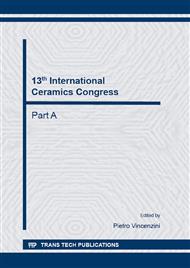p.67
p.73
p.79
p.85
p.91
p.98
p.105
p.113
p.118
Composition – Property Relations in Shear Thickening Fluids
Abstract:
It was shown that fumed silica particles (FS), dispersed in polypropylene glycol (PPG), form shear thickening fluids (STF). PPGs with different molar mass were tested. The best combination of the properties (high viscosity, obtained at high shear rate) present the fluids composed of 7 nm FS and PPG 425. The highest volume fraction of FS, which was possible to disperse in PPG 425, was 25%. This fluid exhibited the highest viscosity. The highest magnitude of shear thickening effect was obtained, however, for 17.5 vol.% of the solid phase. Dynamic oscillatory shear experiments were conducted at either a constant amplitude or frequency. The constant strain amplitude tests showed, that for the frequency sweep, the systems showed viscous properties, except that of 25 vol.% of FS in PPG 425, which exhibited elastic properties in almost entire range of the frequency investigated. For the constant strain sweep, for low strains, the elastic modulus and loss modulus were hardly dependent on the strain, but for relatively high strain, this dependency was increasing. Also the complex viscosity was also growing for high strain values.
Info:
Periodical:
Pages:
91-97
Citation:
Online since:
October 2014
Authors:
Keywords:
Price:
Сopyright:
© 2014 Trans Tech Publications Ltd. All Rights Reserved
Share:
Citation:


